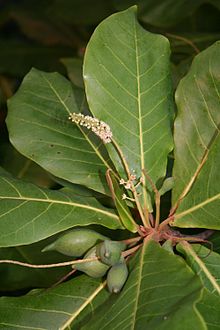Katappenbaum
| Katappenbaum | ||||||||||||
|---|---|---|---|---|---|---|---|---|---|---|---|---|

Katappenbaum ( Terminalia catappa ) |
||||||||||||
| Systematics | ||||||||||||
|
||||||||||||
| Scientific name | ||||||||||||
| Terminalia catappa | ||||||||||||
| L. |
The catappen tree ( Terminalia catappa ), also called sea or sea almond tree , Indian almond or badam , is a species of plant in the genus Myrobalanen ( Terminalia ) from the winged family (Combretaceae). The species is native to Malesia and the western Pacific area , but is also often found outside of the original range.
description
Vegetative characteristics
Katappen trees are (semi) deciduous trees that reach heights of growth of 20 to 25 m. They have a lively , horizontal branching that leads to an open spreading crown . The bark is grayish-brown and, with age, long cracked and scaly. The trunks do not form buttress roots , and the root system does not expand excessively. The elastic wood is reddish with a crossed and twisted grain.
In autumn, the lighter underside, full-margined and simple, obovate to elliptical, rounded, short-stalked up to 15-30 cm long leaves turn decorative yellow and later deep red. The alternate, pseudo whorlish leaves are rounded to blunt or rounded to pointed. The veins are pinnate and lighter, often changing, and raised underneath. Stipules are missing.
Generative characteristics
Katappen trees are single sexed ( monoecious ). In the summer and autumn months, axillary, 6 to 16 cm long, spiked inflorescences are arranged at the branch ends . The upper flowers of the inflorescence are male, and the lower ones are hermaphroditic. The inconspicuous, small, greenish to white, fragrant and sedentary or "pseudo-stemmed" or short-stalked flowers are unisexual or hermaphrodite and five-fold with a simple flower envelope. The male flowers have a 1.5 to 2.5 mm long peduncle. The calyx is cup-shaped, with shaggy hair on the inside and the triangular calyx teeth are 1 to 1.5 mm long. Petals are missing. There are two circles with five protruding stamens, each 2 to 2.5 mm long, with white stamens. The ovary is inferior, in a cylindrical flower cups , and the pen is up to 2 mm long. There is a hairy, orange discus . The pollination is done by insects.
Leathery and smooth, initially yellow or reddish when ripe, 4 to 6 cm long and 2 to 3 cm wide, slightly two-winged and pointed or beaked , edible and ellipsoid drupes ( false fruits ) are formed. The light brown, flattened and elliptical, pointed and fibrous stone core (nut) usually contains a narrow, egg-shaped, approximately 2.5–3.5 cm long seed with a thin, papery seed coat . The stone cores can swim for a long time.
Distribution and locations
This species is native to Malesia and the western Pacific, where it grows mainly on beach areas. In West Africa it is found in areas with heavier rain between Senegal and West Cameroon .
Importance to animals
In Costa Rica , the catap tree is already considered endemic. There, the fruits of the tree are an important source of nutrition for the scarlet macaw , and occasionally also for the large soldier macaw .
use
The pericarp and the core of the fruit are edible, but the shell is very tough and has to be removed beforehand, which is often not easy.
The almond-like seeds are edible and very tasty.
Lumber
In Asia and Africa, the species is often planted to provide shade. The wood is used as lumber due to its ease of processing and is said to have a pleasant smell. In Malaysia it is used for boat and house building. The wood can be soaked in water and gives a yellow color, the bark a black, both solutions are used as coloring agents.
Medical use
The bark also be attributed to medical uses, such as diarrhea, gonorrhea , leucorrhoea , fever and stomach cramps .
The dried leaves are also used in animals in the aquarium hobby (as sea almond tree leaves) as a preventive measure and for the treatment of diseases. The ingredients of the leaves ( flavonoids / tannins , tannins , saponins / triterpinoids) have antibiotic , antifungal , antioxidant , astringent and anti-inflammatory effects. They are used to treat and prevent:
- Fungal infections
- bacterial diseases such as B. Fin rot
- Spawning fungus
- Ectoparasites
- Mucosal damage
- Bite marks and injuries
dye
In Timor , the leaves of the tree are used to dye the traditional fabrics ( tais ), creating shades of green.
literature
- HM Burkill: The useful plants of west tropical Africa. Volume 4, Royal Botanic Gardens, Kew, 1985, 2nd Edition 2000, ISBN 1-900347-13-X .
- Gordon Cheers (Ed.): Botanica: The ABC of Plants. 10,000 species in text and images . Ullmann / Tandem, 2003, ISBN 3-89731-900-4 .
Web links
- Brief description at World Agroforestry (ICRAF) (English)
- Terminalia catappa . In: U. Brunken, M. Schmidt, S. Dressler, T. Janssen, A. Thiombiano, G. Zizka: West African plants - A Photo Guide. Senckenberg Research Institute, Frankfurt am Main 2008.
- Terminalia catappa at Useful Tropical Plants.
- Description in the Flora of Pakistan. (English)
- Description in the Flora of China. (English)
Individual evidence
- ↑ Seemandel Baum - Edelman reforestation project. Retrieved October 9, 2016 .
- ^ Tais Timor-Leste: About Tais ( Memento of August 30, 2017 in the Internet Archive ), accessed on August 29, 2017.


